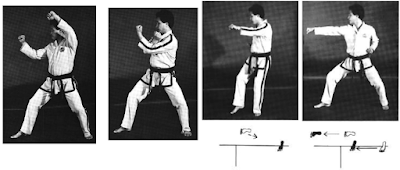- Heian Nidan: Remain in back stance for all three moves
- Pinan Shodan: First two moves in cat stance. Shift into ready stance for move 3
- Pinan Sono Ni: First two moves in cat stance. Slip front foot into riding stance for move 3
None of these are quite what we do in Hwa-Rang; it's just interesting that different karate masters felt a need to alter this set.
Slipping the front foot is not just cosmetic: it can be used to get around an opponent's leg, to create space to pass an arm, or as a sweep. Take a look at the following application for the opening of Won-Hyo from Matthew Sylvester's channel.
 |
| Source: Practical Taekwondo |
Therefore, here is my modified version of the above application.
- Use the crossed-arm chamber for the twin block as a parry-pass. I.e. parry an attack inward with your front arm, then grab and raise up your opponent's arm with your back hand as you step forward. I noticed that in the Encyclopedia, the student performs the move with a half-turned front fist. Though this is likely an error, you can use the half-turned fist as a side backfist strike to your opponent's face or jaw as you lift their arm. Dan Djurdjevic shows something close in the image below.
 |
| Source: Dan Djurdjevic |
- Grab their shirt with your front hand. Pull them in as you perform the upward punch, striking their solar plexus or driving up under their ribs.
- Sweep out your opponent's left leg with your right leg (slipping the right foot back in)
- Use the slide forward to knock out your opponent's hips as you bar the front of their body with the punch, knocking them to the floor.
This sort of hip bump or "wedge throw" is a simple takedown: by ramming into someone with the slide you take their balance. Below is a gif of Lyoto Machida using such a technique in the UFC.
This is also what I think might be going on in Pinan Sono Ni, with the slipping of the front foot into riding stance.
 |
| Source: Bleacher Report |
Sources

David - I would love to show you what we do for this - which matches your thinking of the front hand upset or uppercut strike. The follow up inward shuto (ala Wonhyo) is done to block secondary strike and counter to face. Are you on FaceBook? https://www.facebook.com/groups/jdklibrary/permalink/341606222854483/
ReplyDelete